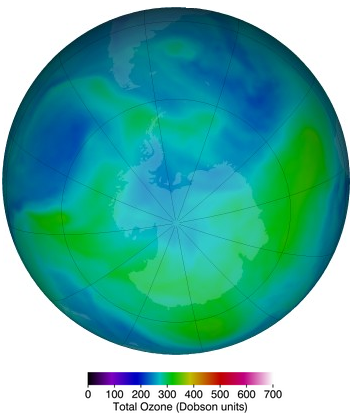Atmospheric ozone plays a critical role in the biosphere by absorbing harmful ultraviolet radiation in the stratosphere—the layer of the atmosphere about 10 to 50 km (6 to 30 mi) above Earth’s surface. Since the adoption of the Montreal Protocol in 1987 banning chemicals that deplete this ozone layer, levels of chlorofluorocarbons (CFCs) and hydrochlorofluorocarbons (HCFCs) in the stratosphere have been declining. As a result, the ozone hole—an area of severely depleted ozone in the stratosphere above Antarctica—appears to be on schedule to recover sometime between 2040 and 2080. To avoid further delay in the ozone-hole recovery, scientists continually monitor the atmosphere for any new traces of CFCs or HCFCs. Much to their surprise, scientists reported in the Proceedings of the National Academy of Science, U.S.A. (February 2021) the discovery of three HCFCs that have no known use; that is, these chemicals should not exist according to manufacturing and emissions records worldwide. See also: Air pollution; Antarctica; Halogenated hydrocarbon; Ozone; Stratosphere; Stratospheric ozone

HCFCs are commonly used as solvents, refrigerants, and aerosol-can propellants. The three HCFCs found in the 2021 study are HCFC-132b (CH2ClCClF2), HCFC-133a (CH2ClCF3), and HCFC-31 (CH2ClF). In fact, CH2ClCClF2 had never been detected in the atmosphere before. Researchers believe that these “puzzling” HCFCs are byproducts that escaped from fluorocarbon production facilities. For example, emissions of CH2ClCF3 and CH2ClF most likely occurred during the manufacture of refrigerants. In addition, CH2ClCClF2 is thought to be a precursor to a known refrigerant. Nearly all emissions of the three HCFCs appear to be coming from Asian sources. Oddly enough, this is good news because prior findings of unexpected CFC and HCFC emissions have been traced to their sources and eliminated. By early detection of compounds that have the potential to destroy stratospheric ozone, the researchers expect environmental enforcement and mitigation to occur at the emission sources, which, after all, is how the Montreal Protocol is designed to work. See also: Fluorocarbon; Refrigeration





